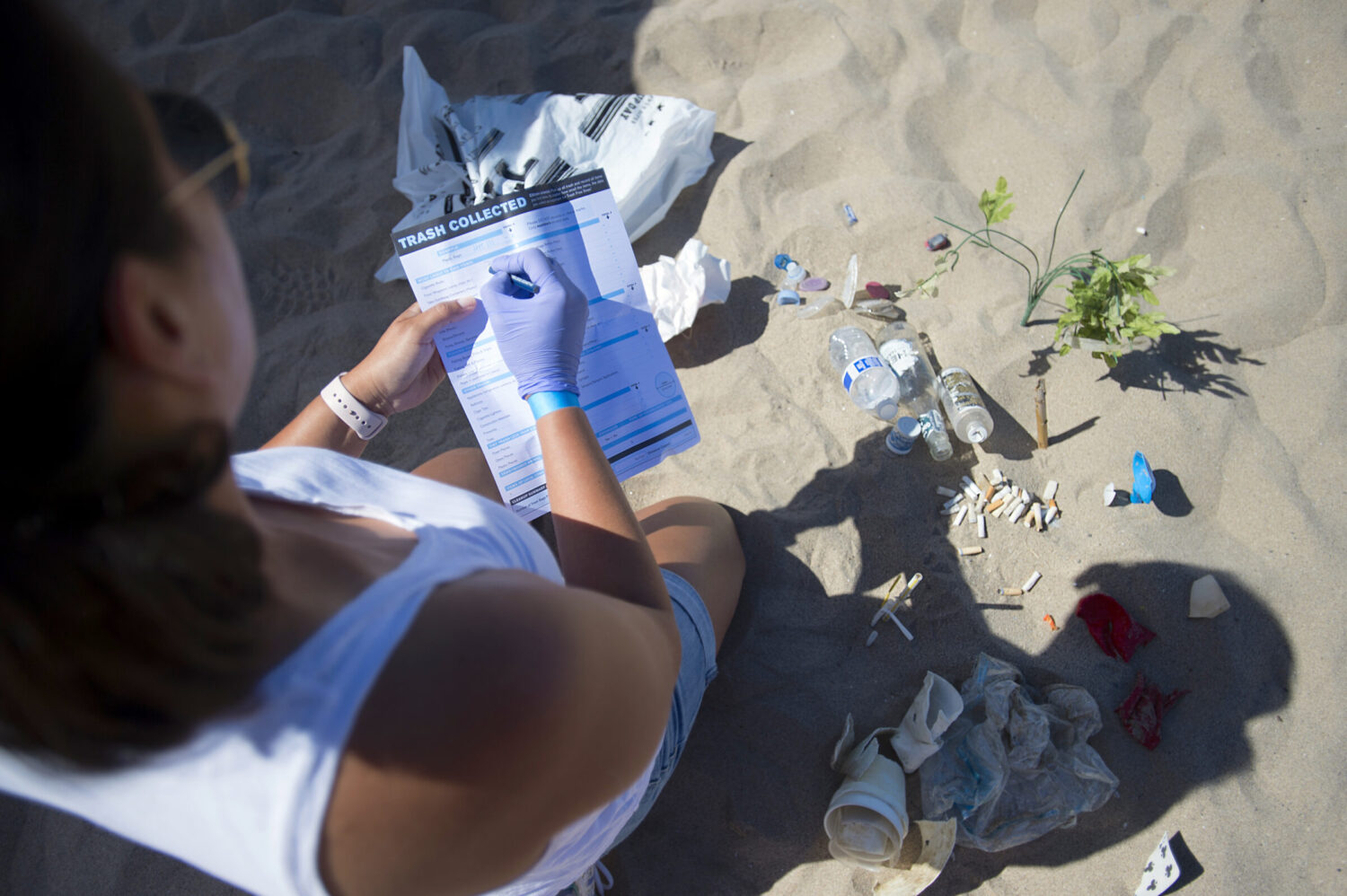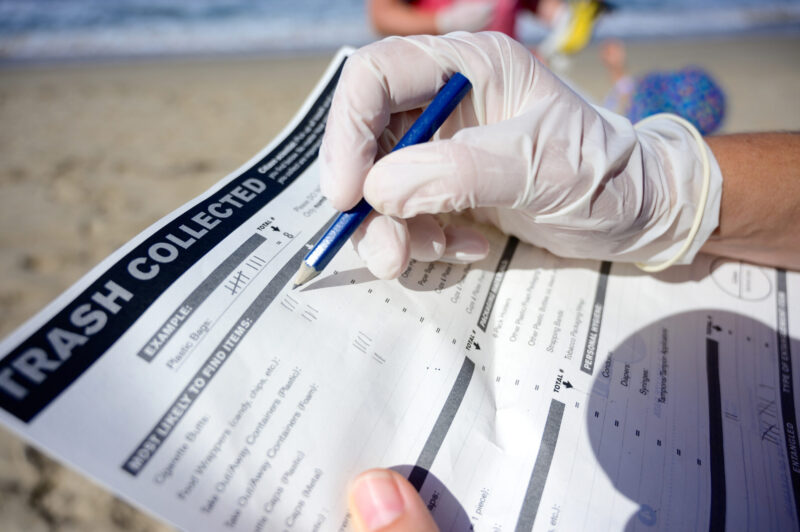From Beginning to End: Tracking Marine Debris Data

Photo by Mayra Vasquez. Courtesy of Los Angeles County.
Beach Programs Manager Emely Garcia shares where marine debris and ocean pollution start, and how Heal the Bay uses community science, data collection, and science-based advocacy to develop solutions.
Ocean pollution begins at our front doors. Each year thousands of pounds of trash and plastic waste are discharged through the storm drain system, ending up on our LA County beaches. Before trash makes its way into the storm drain system and on to the beaches, it litters our local streets, waterways, and parks, harming wildlife and impacting their habitats. Scientists estimate that about 80% of marine debris comes from our neighborhoods and communities.
To understand the problem of marine debris more completely, we need to collect local litter and pollution data in order to develop data-driven solutions. Now more than ever, we need remote support with data collection. We encourage curious, passionate Heal the Bay volunteers to take part in a DIY cleanup and data collection. Gathering valuable litter data around your neighborhood helps us continue to battle ocean-bound litter.
 Photo by Venice Paparazzi. Courtesy of Dockweiler Youth Center and LA County Dept of Beaches & Harbors.
Photo by Venice Paparazzi. Courtesy of Dockweiler Youth Center and LA County Dept of Beaches & Harbors.
Heal the Bay uses our beach cleanup data to inform critical environmental and public policy. For example, in 2014, the City of Los Angeles’ plastic bag ban went into effect, following years of advocacy by our Science and Policy team. Thanks in part to that effort, we were able to implement a state-wide California bag ban in 2016, and eight more states have implemented bag bans since then. Since these bag bans went into effect, our data shows that the number of plastic bags picked up at cleanups has decreased drastically. This data makes a difference. With marine debris data and your help, we can continue to tackle clean water issues and toxic plastic pollution with science-based advocacy.
Turn the Tide: Tracking Data
If we want to see change, we need to combine personal action with collective action. Volunteers can participate in scientific research to fight ocean pollution by joining the community science marine debris data movement. Follow these steps to participate in community science on your next neighborhood walk.
View this post on Instagram
Get Involved
Heal the Bay has partnered with the National Oceanic and Atmospheric Administration to offer our official cleanup data cards digitally. With the Marine Debris Tracker app, you can capture location through GPS, record debris items, attach photos, and track statistics in real time. Join the thousands of community scientists from all over the world who have logged more than 2 million pieces of litter on the app.
To begin collecting valuable debris data in your community, download the mobile Marine Debris Tracker app on a smart phone or tablet through your app store or Google Play. Here are some helpful cleanup tips and step-by-step data tracking instructions to get you started:
How to Track Data
Step 1. Decide where you will collect your data. Find a location that is accessible to you and walking distance from where you live. Open the Marine Debris Tracker app and select “Start Tracking”.
Step 2. Next, select the Heal the Bay icon from the list of partner organizations. Selecting Heal the Bay allows you to participate in local LA County marine debris tracking efforts.
Cleanup Pro Tip –Gather your materials and stay safe
- Cleanup supplies: A mask, work gloves, and an old bucket or bag to collect trash in.
- Pack essentials: Pack items like a first aid kit, a filled reusable water bottle, and some of your favorite snacks to stay fueled and hydrated.
- Watch our Cleanup Safety Video or read our Cleanup Safety Talk, and remember to NOT pick up anything you are not comfortable picking up.
Step 3. Once the Heal the Bay page is selected you will see a list of top community trackers. Log plenty of debris items and get your name to the top of the ranking list. You can also encourage family and friends to participate for some friendly competition.
Cleanup Pro Tip-
- Adhere to county guidelines and respect any recreational space closures.
- Limit your cleanup group participants to only the people in your household to accommodate physical distancing and help reduce the spread of COVID-19. If you see other people while you are outside, make sure to stay at least 6 feet away.
Step 4. Track litter! The icons in orange are debris categories you can hit the each category to bring up the list or scroll down to see all items listed on our digital data card. Be sure to hit the add button to track your find.
Cleanup Pro Tip-
- You can collect data for as long as you’d like. We recommend two hour cleanups. One hour going out, and one hour coming back to your start location.
- Be aware of the elements. Wear closed-toed shoes and protective sun gear, like sunglasses, a hat, and sunscreen. And stay hydrated with you reusable water bottle.
Step 5. Before submitting your data, enter in any details that might apply by filling out the Heal the Bay Volunteer survey. Here you can include details that apply to your group by checking the boxes or typing any information that may apply.
Cleanup Pro Tip
- After filling out the survey, submit your data by hitting save and toss your collected trash in the nearest waste receptacle.
 Remember, your observations could lead to the next breakthrough. Finding ways to take individual and community action makes the fight against pollution more effective. Thanks for tracking valuable debris data, and being a part of this amazing cleanup effort.
Remember, your observations could lead to the next breakthrough. Finding ways to take individual and community action makes the fight against pollution more effective. Thanks for tracking valuable debris data, and being a part of this amazing cleanup effort.
Learn more about our newly adapted Adopt-A-Beach cleanup program and challenge.


